Trams in Europe
Europe has an extensive number of tramway networks. Some of these networks have been upgraded to light rail standards, called Stadtbahn in Germany, premetros in Belgium, sneltram in the Netherlands, and fast trams in some other countries.
Overview

All the former communist countries of Central and Eastern Europe, excluding Lithuania, the Republic of Macedonia, Montenegro, Moldova and Slovenia, have extensive tram infrastructure. Industrial freight use of city tram lines was a widespread practice until the 1960s but has since mostly disappeared. Another factor is an increasing replacement of trams with trolleybuses as cities face a rapid increase in traffic and such replacement often allows to dedicate bigger parts of the street to cars. One of the exceptions is Warsaw, Poland, where the last trolleybus line was closed in the year 1995 due to high maintenance costs, and replaced with buses. Czech ČKD Tatra and the Hungarian Ganz factories were notable manufacturers of trams.


In recent decades, tram networks in countries including Britain, Ireland, France, Germany, Spain and Portugal have grown considerably. The Netherlands, which already makes extensive use of trams, has plans to expand tram services to two additional cities.[1]
Germany did not undergo the extensive tramway closure programmes that were carried out in other European countries and many cities retain their original tram networks. In some places, tram networks have been added or expanded through the introduction of hybrid tram-train or stadtbahn systems which may combine standard railway, on-street and underground operations. Notable examples include the systems in Cologne and Karlsruhe. In Frankfurt-am-Main, many tram lines were transferred to U-Bahn operation.
In the United Kingdom, investment in public transport in the late 1980s turned to light rail as an alternative to more costly underground railway solutions, with the opening of the Tyne and Wear Metro (1980) and the Docklands Light Railway in London (1987) systems. However, the first British city to reintroduce on-street trams was Manchester, with the opening of its Metrolink network in 1992.[2] Several other UK cities followed with their own modern tram systems, including Sheffield (Supertram, opened 1994), Birmingham and Wolverhampton (Midland Metro, opened 1999), London (London Tramlink, opened 2000) and Nottingham (Nottingham Express Transit, opened 2004). Many of these tram cities are planning or building network extensions (construction is in progress in Manchester, Nottingham and Birmingham/Wolverhampton) and several more tram systems are being proposed or are under construction, such as Edinburgh Trams, Belfast EWAY (proposed) and Liverpool Merseytram (proposed). Other tramway projects have not made it beyond the proposal stage because of funding problems, for example London's Cross River Tram and the Leeds Supertram, which is now to be a trolleybus system.
Paris reintroduced trams with line T1 in 1992, and many French cities have seen a similar revival,[3] for example the Tramway de Grenoble and the Montpellier trams.
The Czech capital Prague plans one new line and the extension of eight others between 2007 and 2016, with an official of the Prague Public Transport Company stating that "In Europe in the past 10 years, tram transportation is the preferred way of transit; we can say that tram transportation is going through its renaissance period".[4]
In Luxembourg City, the capital of Luxembourg, the construction of a new tramway line has begun in 2014 with an opening of part of the line scheduled for mid 2017,[5] thus reintroducing that means of transport after it had been completely replaced by buses in the early 1960s.
The new line will connect, once completed in 2020/21, the following parts of the city: the Central station, the historical city centre (which is part of the World Cultural Heritage List of the UNESCO), the Kirchberg borough (home of several major institutions of the European Union) and the International Airport of Luxembourg, called Findel.
Austria

In Austria, Gmunden, Graz, Innsbruck, Linz and Vienna all have tramway systems. With 173.4 km of track, Vienna's network is one of the largest in the world. The cars have been constantly modernised over the years and many are now ultra low-floored.[6] Many of the Austrian tramlines have been in constant operation since they were first opened. Vienna started with horse trams in 1865 and with electrification following in 1897. Graz had horse trams in 1878 and electric cars in 1898 while Linz goes back to 1880 with electrification in 1897.[7] The Gmunden Tramway, only 2.3 km long, is currently one of the shortest in the world. With gradients of up to 9.6%,[8] it is also one of the steepest and has become a popular tourist attraction.[9] Innsbruck, which traditionally used second-hand trams from other cities, has recently replaced its whole fleet with 32 Bombardier low-floor cars (as of Summer 2009).[10] The Pöstlingbergbahn, in Linz, is an unusual "mountain tramway", which has a gradient of 10.6%—one of the world's steepest gradients on a surviving adhesion-only railway[11]—and now reaches the city centre via the tracks of the urban tram system.
Belarus
There are 4 tram systems in Belarus currently: Minsk, Mazyr, Novopolotsk and Vitebsk.
Belgium

In Belgium an extensive system of tram-like local railways called Vicinal or Buurtspoorweg lines had a greater route kilometre length than the main-line railway system. The only survivors of the Vicinal system are the Kusttram (which almost reaches France at one end and the Netherlands at the other, making it the longest tram line in the world) - and two short lines that form part of the Charleroi Pre-metro. Urban tram networks exist in Antwerp, Ghent and Brussels, and are gradually being extended.
Bosnia and Herzegovina

Sarajevo was the first city in Europe to have a full-time (from dawn to dusk) operational electric tram line in 1885,[12] introduced shortly after the city became part of the Austro-Hungarian empire. Since then, the trams have been important in the development and expansion of the city.
Many trams were badly damaged during the Bosnian war for independence. Several European countries donated trams out of service to Sarajevo in the years after the war.
In recent years, the authorities have gradually upgraded to more modern vehicles to expand the fleet.
Bulgaria
Sofia had its first horse-drawn tram in operation in 1898. On 1 January 1901 the electric tram system was inaugurated and had 25 cars and 10 carriages and the total length of the lines was 25 km. Currently Sofia's extensive tram network consists of 16 routes, 3 of which are operated on standard gauge. Due to the construction of the Sofia Metro there were some closures and retracing, but nonetheless the system continues to be one of the largest in Europe. According to the official website, as of 2006 there are 308 km of track, with 190 trams in service on any given weekday.[13]
Croatia
Zagreb has had a tram service since September 5, 1891. Nowadays it is an extensive tram network with 15 daily-lines and 4 night-lines covering over 116 km (72 mi) of tracks through 255 stations. Services operate to high frequencies and are surprisingly efficient despite the high patronage numbers, and little priority on the streets for vehicles. ZET, the major transit authority in Zagreb has ordered 140 and 70 shorter models new 100% low-floor trams from Croatian consortium Crotram. As of 2010, all of these locally produced, low-floor Crotram trams have been delivered, with a mixture of vehicle types in operation (including Czech Tatra Cars and various locally produced trams). Zagreb is one of the few tram networks in the world where most of the operations run at the kerb.
The only other Croatian city with trams still in operation is Osijek. The first tram route commenced in 1884 (connecting the railway station and city square) and trams have been in constant existence since. Throughout 2006–07, rolling stock is progressively being refurbished and modernised. 2 lines presently exist, with another 2 extensions in planning, doubling the network length.
Dubrovnik, Opatija, Pula and Rijeka also had tram traffic.
Czech Republic
Czech Republic is well known for its extensive tram infrastructure, often present even in small cities. The largest is the Prague Tram System with 141 kilometres of track and 35 lines (9 of them night-lines). Other cities with a tram system are Brno, Ostrava, Plzeň, Olomouc, Most and Litvínov (common network), Liberec (including intercity line to Jablonec). Tram networks in nine other cities were closed down mainly during the 1960s and replaced with trolleybuses or buses.
Before changes in 1989 ČKD Tatra in Prague was the largest tram producer in the world, mainly exporting its trams to Soviet Bloc countries. Production was definitely stopped in 2001 after ČKD was sold to Siemens AG. The tradition of tram producing is continuing in Škoda Transportation, Inekon and PRAGOIMEX.
Denmark
In Denmark there is no tramway system. However, a system is under construction in Aarhus, the Aarhus Letbane where a new town tramway will be combined with converted local railways, in operation 2016. Construction has also already begun of the tramway system in Odense with expected completion in 2019/2020. In Copenhagen, there are also plans for tramways. There were trams in Denmark during the period 1884-1972.
Estonia
In Estonia trams are used only in the capital, Tallinn. There has been a growing tram network in Tallinn since 1888, when traffic was started by horse-powered trams. The first line was electrified on October 28, 1925. Estonian-built electric trams were also used, with some gas-powered trams also used in the 1920s and 1930s. The last part of the system to be electrified was the spur to Kopli in 1951 (also converted to double track at the time) and it only was connected to the rest of the network in 1953.
Since 1955 to 1988 German-built trams were used. The first Czechoslovakian-built tram arrived in 1973. In 2007, 56 Tatra KT4SUs, 12 KTNF6s (rebuilt KT4SUs) and 23 KT4Ds (used trams bought from Germany) are in use. There are four lines, with total length of tramlines 39 km. Plans have been in the works since the late 1970s to open a light rail line from one of the suburbs, Lasnamäe, to the city centre. The deadlines have been postponed many times.
As of early 2014, a much more moderate extension is under construction, to eventually extend the network to Tallinn airport. This is the first extension to the network since 1955, when the stretch to Ülemiste district was lengthened. The first phase of the extension, which is little more than a new return loop around a new shopping centre also under construction, should be ready in 2015 and the second phase to undercut the mainline railroad to reach the airport has been stated to be carried out in 2020-2022.
The track and electricity distribution architectures of the system are also under major renovation, to make the system accommodate the 20 new vehicles delivered by CAF by 2016. The new vehicles will first operate only on lines 3 and 4, tracks to Kopli may be restored later.
Finland

In Finland, there have been three cities with trams: Helsinki, Turku and Viipuri. Only Helsinki still has retained a tram network. The system has operated continuously since 1891 and it was fully electrified by 1901. Currently there are 12 tram lines on 89.5 kilometres of track. Around 200,000 passengers use the tram network each weekday and within the inner city of Helsinki trams have established a position as the main form of public transport. The network is being actively developed, with a new line opened in 2008 and more lines planned to connect new residential areas to be built in 2009–2015. In 2009, the city called for bids on 40 new low-floor trams with an option for another 50.
The City of Tampere has not yet decided to build a tram system for the city. The trains will be more modern than Helsinki's ones, where the trams' design is more classic and traditional.[14]
The cities of Oulu and Turku have somewhat planned a tram network, Turku has accepted The Light Rail Network of Turku's principal plan as obeyed normatively.[15] Even though Oulu's vice mayor rejected the idea,[16] The city included it in The Zoning Scheme of New Oulu as "normative" and "necessary"[17]
France

Despite the closure of most of France's tram systems in previous decades, a rapidly growing number of France's major cities boast new tram networks, including Paris, Lyon, Marseille, Nantes, Grenoble, Montpellier, St Etienne and Strasbourg (Strasbourg has the largest French network). Since the 1990s, tram systems have been introduced, or expanded, in twenty-seven towns and cities Trams in France#Current tramway systems, with many experiments such as ground level power supply in Bordeaux (to avoid the need for overhead line equipment) or trolleybus-tram-BRT hybrids in Nancy and Caen with Bombardier's Guided Light Transit. Smaller cities like Aubagne or Avignon are now planning tram lines.
Germany and Switzerland
In Germany and Switzerland (where the word for tramway is "Straßenbahn", meaning street railway in German, although "Tram" or "Trambahn" is also used) are notable for their large numbers of extensive tram systems, although even in these countries, many systems were closed after the Second World War, such as the Hamburg tramway, which last ran in 1978. Following the renaissance of trams in France and positive experience with tram-train and similar concepts (e.g. the Karlsruhe model), most German tramways are expanding, including new systems in cities that had previously abandoned them or entirely new systems in cities without any tram history.
Light rail in Germany
Stadtbahn, literally city railway in the German language, is the term for light rail in Germany and is the predecessor of the North American light rail. Most German light rail systems were started in the 1960s and 1970s with the intention of establishing full-scale underground/subway structures, or U-Bahn (short for Untergrundbahn) systems. By the 1980s virtually all cities had abandoned these plans due to the high costs of converting tramways, and the most common systems now are a mixture of tramway-like operations in suburban areas, and a U-Bahn like mode of operation, featuring underground stations, in the city centres.
Greece
Tram used to be the main means of mass transport in Athens and Thessaloniki before World War II.
The first trams in Athens begun operating in 1882. They were light vehicles drawn by 3 horses moving on an extensive network throughout the city centre and a line reaching the suburb of Faliro. After the German Occupation the tram started to decline. Lines were gradually abandoned and later dismantled. Gradually, the tram network was completely dismantled and replaced with trolleybuses, which were considered more appropriate and agile for the urban environment at that time. It is frequently mentioned somehow poetically that "The last bell of the Athens Tram rang on the midnight of October 16, 1960". The tram had been a trademark of Athens until that date, and it is still viewed nostalgically in present times. However, there was one tram line left in Perama, which remained in operation until April 1977.
Athens reinstated a modern tramline for the 2004 Summer Olympics with vehicles designed by the famous Ferrari designer Sergio Pininfarina. A total of 3 paths and 24 km of tramlines, which run from Syntagma Square to Eden Station (the seaside junction), and from Peace & Friendship Stadium in Piraeus to Glyfada along the coast. The tram lines were expanded by 0,7 km from Glyfada to Voula (completed November 2007), and will expand 2,5 km further from Peace & Friendship Stadium to Piraeus centre by 2017.
Τhere are 3 lines in Athens tram:
- 3 (Thoukididis) S.E.F-Voula Voula-S.E.F.
- 4 (Aristotelis) Syntagma-S.E.F.
- 5 (Platonas) Syntagma-Voula
Hungary
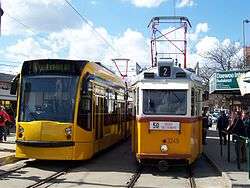
Hungarian cities with tram service are Budapest, Miskolc, Debrecen, and Szeged. The Budapest network, at 156 km, is the backbone of the capital's transit system and is by far the most extensive in the country. Routes 4 and 6 in Budapest are the busiest in the world; 54-metre long tram-cars run at 2 to 3 minute intervals at peak time and are usually packed with people. Historically, Hungary had tram networks in Sopron until 1923, Pécs until 1960, Nyíregyháza until 1969 and Szombathely until 1974.
Ireland
Replacing a once-extensive network of Dublin tramways, in 2004, the Irish capital Dublin opened the first two lines of a new light-rail system known as Luas, the Irish word for "speed". It features on-street running in the city centre, but is considered a light-rail system because it runs along a dedicated right-of-way for much of its suburban route. There are seven more Luas projects planned, all of which are to be complete by 2015. Two light-metro lines fully segregated from traffic were planned to be built by 2014, but were cancelled due to the economic downturn.
Plans also exist for light-rail systems in the cities of Cork (which had a modest system up to the early 20th century) and Galway, both of which have strong support from the city councils and city residents alike. In January 2007, the Green Party promised that, if it formed part of the next government in 2007, they would have light rail systems built in these cities. In addition, there is also a smaller campaign for a light-rail system in Limerick.
- See also
- Luas (Dublin's light-rail network).
- Dublin Metro (Future light-metro in Dublin).
- Corrib Light Rail (a proposed light-rail network for Galway).
- Transport 21.
Italy
In Italy electric trams have run from the last years of 19th century (the first horse-drawn line opened in Turin in 1871). The first electric line was opened in Milan in 1893.
Italian cities operating tramways are:
- Bergamo - since 2009 (1 suburban light rail line, 12.5 km, operated by TEB Bergamo).
- Cagliari - since 2008 (1 urban line, 6.3 km, operated by FdS).
- Florence - since 2010 (1 urban line, other 2 under construction, 7.4 km, operated by a joint venture GEST between municipal transport company ATAF Firenze and RATP Paris).
- Messina - since 2003 (1 urban line, 7.7 km, operated by ATM Messina).
- Mestre/Venice - since 2010 (1 urban line, 7.7 km, operated by ACTV).
- Milan - non-stop since 1881 (17 urban lines, 1 interurban line, totalling 115 km, operated by ATM).
- Naples - non-stop since 1875 (3 urban lines, totalling 11.8 km, operated by ANM Napoli); see Trams in Naples.
- Padua - since 2007 (1 Translohr urban line, 10.3 km, operated by APS Padova).
- Palermo - since 2015 (4 urban lines)
- Rome - non-stop since 1877 (6 urban lines, totalling 40 km, operated by ATAC Roma). See Rome tram.
- Sassari - since 2006 (1 tram-train line, 4.3 km, operated by FdS); see Sassari Tram-train.
- Trieste - non-stop since 1902 (1 hybrid tramway-funicular railway line, 5.2 km, operated by Trieste Trasporti).
- Turin - non-stop since 1871 (9 urban lines, totalling 84 km, operated by GTT Torino).
Latvia

There are 3 tram systems in Latvia currently: Riga (see Rīgas Satiksme), Daugavpils (see Daugavpils Tramway) and Liepāja (see Liepājas tramvajs).
Malta
A tramway service was inaugurated in Malta on 23 February 1905, linking the capital Valletta with Floriana, Ħamrun, Birkirkara, the Three Cities, Qormi and Żebbuġ.[18] The tram service competed with the Malta Railway and later the Malta buses. It eventually closed down on 15 December 1929.[19]
The reintroduction of trams in Malta has been considered by the Ministry of Transport.[20]
Netherlands
In the Netherlands many local light railways were referred to as trams, even where the steam locomotives did not have enclosed motion. Today, extensive tram networks exist in:
Norway
There are three tramways (Norwegian: Trikk) in Norway; the Oslo Tramway that operates as a hybrid between a light rail and a street tram with six lines, and the suburban line of Trondheim Tramway, the Gråkall Line. The Bergen Tramway was closed in 1965, but the new Bergen Light Rail opened in 2010.
Poland
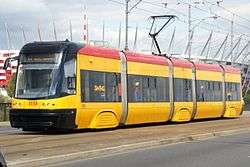
There are 15 tram systems in Poland currently in operation: Bydgoszcz, Częstochowa, Elbląg, Gdańsk, Gorzów Wielkopolski, Upper Silesian Industrial Region, Grudziądz, Kraków, Łódź, Olsztyn (opened in 2015), Poznań, Szczecin, Toruń, Warsaw and Wrocław. The largest systems are in Upper Silesia (Silesian Interurbans connecting 13 cities) with 317 km of tracks and 35 lines, Warsaw with 280 km of tracks and 34 lines and Łódź with 217 km of tracks and 28 lines. New lines are currently under construction in most cities. A system in Płock was planned but the construction was postponed indefinitely in 2011.
Portugal
The Lisbon tramway network has been managed by the Companhia Carris de Ferro de Lisboa (Carris) (“Lisbon Iron Rails Company”) for over a century. The current fleet (since 1995) includes authentic vintage cars (700s), units made from vintage bodies powered by modern engines (541-585 and 4-11), and fully modern, articulated trams (501-510). In Porto a tram network has been in operation since 12 September 1895, making it the first electric tramway in the Iberian Peninsula.[21] Most routes were closed in the 1970s and 1980s, but one survived and some closed sections have reopened in the 2000s, so that currently four routes (1, 18, 22 and T) are in operation. A heritage tram line operates seasonally in Sintra. Repeated reductions of service and extension started in 1954, until it finally closed in 1975. It was re-opened in 1980 using a section of the former line and surviving trams; it has since recovered most of its original extension.[22] Almada has a light rail network, which opened in 2007 after two decades of planning and postponing, the Metro Sul do Tejo; its expansion to Seixal and Barreiro is likewise planned.
Romania
There are, currently, 11 tram systems in Romania: Arad, Botoşani, Brăila, Bucharest, Cluj-Napoca, Craiova, Galaţi, Iaşi, Oradea, Ploieşti, Timişoara.
Serbia
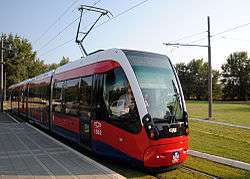
Belgrade has a large tram-network with 12 lines on 127.3 km of track. The system is operated with around 250 units and with ČKD Tatra KT4 and DUEWAG Be 4/6 trams. The first horse-drawn tram line was introduced in October 1892 and the first electric one in 1894. There are longterm plans to build a new track to the Mirijevo neighbourhood, in the east of the city.
Previously the cities of Niš, Novi Sad, and Subotica had tram networks as well, but those were discontinued in the 1950s in Novi Sad and Niš, with the Subotica system suffered the axe in 1974.
Slovakia
Bratislava and Kosice have a tram system.
First trams in Bratislava started in 1895, the tram system currently has 8 lines in service with the length of tracks of 39.5 km. There is a new tram line being built across the Danube river on the right bank to the Petrzalka city part. Trams are operating on 1000mm gauge. The tram cars in service contain PCC cars from CKD-Tatra of the type T3SUCS, with modernized variations of T3SU-M, T3CS-M, T3G, T3S, T3AS, T3Mod and T3P, K2S, which are modernized CKD-Tatra K2 trams, type T6A5 and the newest additions 30x Skoda ForCity 29T and 30x Skoda ForCity 30T. Original T3SUCS trains are no more in service on regular basis, they are being held as a reserve. There are multiple plans for expanding the network, yet the funding is currently unclear.
Košice started with trams in 1914, after wagons pulled by horses and steam tramway. The length of tracks is 34 km, from which 13 is a fast tram to the steel mill U.S. Steel Kosice. There are 7 lines within the city in service and 8 fast tram lines to US Steel. There are several types of trams in service, CKD-Tatra T3SUCS, with 1 modernized vagon of the T3Mod type, CKD-Tatra KT8D5 with a few modernized KT8D5R.N2, CKD-Tatra T6A5, 1x Vario LF and 33x Vario LF2. All T3SUCS and T3Mod are no more in service on regular basis, they are held as a reserve.
Spain
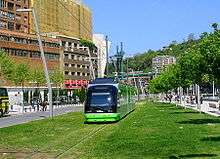
In Spain modern tram networks have been opened in Alicante, Barcelona (Trambaix and Trambesòs), Bilbao, Madrid (Metro Ligero ML1, ML2 and ML3), Murcia, Parla, Santa Cruz de Tenerife, Seville (MetroCentro), Valencia, Vélez-Málaga, Vitoria-Gasteiz and Zaragoza.
Sweden


The most extensive network in Sweden is in Gothenburg (190 km line length on a total track length of 80 km, with 101 million rides in 2008. See further in Gothenburg tram).
Stockholm has had horse-drawn trams since 1877. However, the large tram system was dismantled starting at 1957 with the last tram running in September 1967. Presently Stockholm has four lines on three non-connected systems owned by Storstockholms Lokaltrafik (slightly less than 30 km of track and line length in total): Spårväg City; Lidingöbanan; Nockebybanan and Tvärbanan. There are many plans for future extensions and two projects are in active development.
Norrköping has an 18.7 km tram network consisting of two radial lines, extended 5 kilometres to a southern suburb in 2006-2011.
In the southern university town of Lund the plan to build a tram line was approved in December 2015.
There is a single track heritage line in Malmö since 1987, the last "real" tram line was closed in 1973. Malmö city officials decided in October 2008 that the city should have at least one light rail line up and running before 2020, and up to six lines after that.
A combined tramway museum and heritage tramway is located at Malmköping, Södermanland County, maintained by Svenska Spårvägssällskapet (English: Swedish Tramway Society).
Turkey
The first tram line in Istanbul was constructed by Konstantin Karapano Efendi and started operating in July 31, 1871 between the districts of Azapkapi and Ortaköy. In 1869, the tram company "Dersaated Tramvay Şirketi" was established. 430 horses were used to draw the 45 carriages, including 15 summer-type and some double-deckers, on meter gauge track. In 1912, the horse-drawn tram had to cease to operate for one year because the Ministry of Defence sent all the horses to the front during the Balkan War. The tram network was electrified by overhead contact wire on February 2, 1914. The tram began to run on the Anatolian part of Istanbul on June 8, 1928 between Üsküdar and Kisikli. By the 1950s, the length of the tram lines reached 130 km. The trams were on service on the European part until August 12, 1961 and on the Anatolian part until November 14, 1966.[23]
Heritage trams returned to Istiklal Caddesi in 1990 and in Moda in 2003. Modern trams began service on the European side in 1992 and have since been expanded.
Istanbul is the only city in European Turkey with operating trams. In Anatolia, there are operating trams in Adana, Antalya, Bursa, Eskişehir, Gaziantep, and Kayseri. Izmir formerly had trams and new lines are currently being planned.
United Kingdom

Britain had the first European trams, and until 1935 a large and comprehensive network of systems. For example, it was possible to go by tram across northwest England, from Liverpool to Ashton-under-Lyne (approx. 43 miles) using connecting systems. Most of the UK systems were municipally owned. These had often been inherited from private sector operators, who had been granted limited-term leases and did not maintain their networks beyond bare necessities as the time for a forced handover approached. When councils acquired these dilapidated systems, it was almost always cheaper to replace them with buses. The 1931 Royal Commission on traffic argued that trams held up cars.[24]
In the UK, there was some public reaction against tramway abandonment, but seemingly less than the similarly unsuccessful reaction against the Beeching Rail closures in the 1960s. Some people, particularly motorists, welcomed the removal of trams, which were perceived as obstructing the highway.[25] Not all passengers transferred to replacement buses, and car ownership continued to increase.
In the UK, tram systems were mainly dismantled between 1920 and 1960, and after the closure of Glasgow's once extensive GCT network in 1962 only Blackpool's survived (see Blackpool tramway), although a funicular line continued to operate up the Great Orme in Llandudno.
However, in recent years new lines have been opened in:
- Manchester (Metrolink) - 93 stops over 92.5 km (57 miles)
- Sheffield (Supertram) - 48 stops over 29 km (18 miles)
- West Midlands (Midland Metro) - 23 stops over 21.6 km (13 miles)
- South London (London Tramlink) - 39 stops over 28 km (17 miles)
- Nottingham (NET) - 50 stops over 32 km (20 miles)
- Edinburgh (Edinburgh Trams) - 16 stops over 14 km (8.7 miles)
Several others are under consideration, and extensions are under construction in Manchester, and the West Midlands. There are currently proposal to re introduce trams to Bath Bath Electric Tramways Company
Former USSR/Russia and CIS
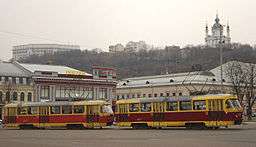
In many cities of Russia, Ukraine, in Armenia, Georgia, Azerbaijan and Uzbekistan tramways have been facing difficulties since the disintegration of the USSR. Tramways of Shakhty, Arkhangelsk, Astrakhan, Grozny, Tbilisi, Baku, Yerevan and Tashkent have been abandoned. Some tramway systems have suffered extensive closures of vital parts of network (including Saint Petersburg, Moscow, Kiev) and some are facing threats of closures (Nizhniy Novgorod) or even total abandonment (Voronezh). Saint Petersburg's tramway network is largest in Europe, once had been the largest in the world, but has yielded its position to Melbourne. Tram in Molochne (Crimea, Ukraine) - is the smallest tram system in the world.

See also
- List of light-rail and tramway systems in Europe
- List of town tramway systems in Europe
- Tram
- Light rail
References
- ↑ Edo Sturm (2008-02-12). "Steden willen weer terug naar de tram". Trouw (in Dutch). Netherlands. Retrieved 2008-08-13.
- ↑ Docherty, Iain; Shaw, Jon (2003). A New Deal for Transport?: The UK's Struggle with the Sustainable Transport Agenda. Blackwell Publishing. p. 138. ISBN 978-1-4051-0631-3.
- ↑ "French rediscover love for streetcars". UPI. Paris. 2008-07-18. Retrieved 2008-08-13.
- ↑ Kimberly Ashton (2007-12-05). "Tram service to expand". Prague Post. Archived from the original on 7 October 2008. Retrieved 2008-08-13.
- ↑ http://www.luxtram.lu/de/die-linie/kalender/
- ↑ Bus and rail in Austria by Manfred Novy, Project Director, UITP Office 2009. Retrieved 2 March 2009.
- ↑ Wolfgang Kaiser: Straßenbahnen in Österreich. GeraMond Verlag, 2004 ISBN 3-7654-7198-4
- ↑ Taplin, Michael; and Russell, Michael (2002). Trams in Western Europe, p. 8. Harrow Weald, Middlesex (UK): Capital Transport Publishing. ISBN 1-85414-265-8.
- ↑ Verein pro Gemundner Strassenbahn. Retrieved 2 March 2009.
- ↑ Press release from Bombardier, October 2007. Retrieved 2 March 2009. Archived 6 March 2009 at the Wayback Machine.
- ↑ Buckley, Richard (2000). Tramways and Light Railways of Switzerland and Austria (2nd edition), p. 129/139. Gloucester, UK: Light Rail Transit Association. ISBN 0-948106-27-1.
- ↑ http://en.strasbourg-europe.eu/bosnia-and-herzegovina,18143,en.html
- ↑ History of trams in Sofia (in Bulgarian), Centre for Urban Transport. Retrieved January 2013.
- ↑ in finnish
- ↑ (in finnish)
- ↑ (in finnish)
- ↑ Uuden Oulun Yleiskaava - Liitteet 10-13 (PDF) [The Zoning Scheme of New Oulu - attatchments 10-13] (in Finnish). Oulun Kaupunki. 15 January 2016. p. 3.
- ↑ Azzopardi, Nicholas. "Brief History". maltarailway.com. Retrieved 22 October 2015.
- ↑ "'The Story Of the Malta Buses 1931-2011': A must-have publication". The Malta Independent. 29 July 2011. Retrieved 22 October 2015.
- ↑ Simmons, David (5 December 2008). "The Potential For Introducing A Tram Service In Malta" (PDF). Ministry of Transport. Retrieved 22 October 2015.
- ↑ King, B. R.; and Price, J. H. (1995). The Tramways of Portugal (4th edition), p. 41. London: Light Rail Transit Association. ISBN 0-948106-19-0.
- ↑ Lennox Docherty, Bob (September 2008). "Iron whispers in the Pinewoods of Sintra". Tramways & Urban Transit, pp. 364–365. LRTA Publishing.
- ↑ http://www.iett.gov.tr/metin.php?no=190
- ↑ London Trams and Trolleybuses. Retrieved 13 February 2009.
- ↑ The Campaign To Save the London Trams 1946–1952 from the Collected Papers of Alan John Watkins. Retrieved 13 February 2009.
| Wikimedia Commons has media related to Trams in Europe. |




.jpg)



